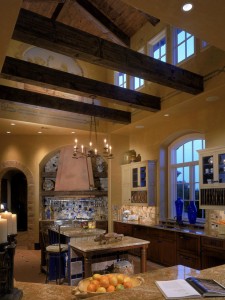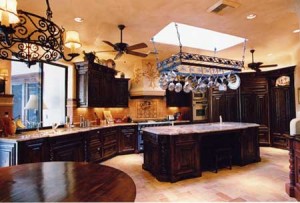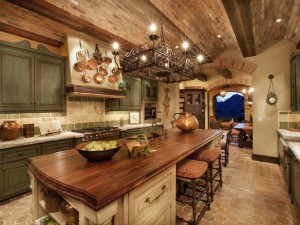Is it the peaceful, rolling hills of the Italian countryside, the quant cobblestone streets, the rich taste of wine straight from the vineyard, or the robust flavors and aroma of Tuscan cuisine? It’s hard to put into words the charm and allure of Tuscany, but it’s something we often try to emulate in our cooking, building, and decorating. If you’re looking to bring a little piece of Tuscany into your home, creating a Tuscan style kitchen may be the perfect way to do so. Here are a few ideas to get you inspired:

-Color: Use varying shades of yellow and orange, like gold and burnt terracotta, as the cornerstone of your design, especially on the walls. But don’t be afraid to use pops of color, like flaming red, luminous blue, and emerald green in your accent pieces.
-Walls: Intricately layered walls will give your kitchen that Old World charm. To create this effect, try a painting technique, such as sponging or antiquing. If you aren’t familiar with these forms of painting, you may want to hire a professional for optimal results. If you decide to take on the challenge yourself, home improvement stores have books and specialty paint and utensils to help you master these techniques.
 -Cabinets: Rich, dark tones are best suited for your cabinetry. Also, you’ll often find cabinets without doors in a Tuscan themed kitchen, in which you can display your kitchen accessories (see Accessories below).
-Cabinets: Rich, dark tones are best suited for your cabinetry. Also, you’ll often find cabinets without doors in a Tuscan themed kitchen, in which you can display your kitchen accessories (see Accessories below).-Backsplash: The kitchen backsplash is often regarded as the heart and soul of a Tuscan kitchen, and it can make a big splash in your room. Rust, gold, cream, and green are popular color choices for the backsplash. You may also want to consider a mural made of tumbled stone tiles to bring out the iconic Tuscan spirit in the space.
-Counters: Stone counters, such as granite, slate, and travertine, are essential to your Tuscan inspired kitchen.
-Floors: For your flooring, stone or quarry tiles in earthy shades will capture the essence of the Tuscan décor. These flooring choices will make you and your visitors feel like you are standing in the heart of a Tuscan villa.

-Furniture: Dining with the family continues to be a symbol of Italian tradition and culture, so a large kitchen table holds a great deal of significance. Luxurious table linens and chair cushions in sultry shades can add extra interest and style to your table. In addition, an island is another integral part of a Tuscan themed kitchen.
-Accessories: Displaying actual kitchen items is the best way to accessorize your cooking space. Rustic dinnerware, urns, spices in glass jars, pots and pans on metal racks, copper and pewter vessels, potted herbs, wine accessories, wrought iron candle holders-- all are perfect finishing touches to your Tuscan kitchen.
With these suggestions (and a little help from your friends at Pizazz Floors), you’ll be on your way to creating a true Italian kitchen. Then instead of dreaming of that little café in Tuscany, just grab some family, friends, food, (and of course the vino) and enjoy your own Tuscan inspired kitchen.


